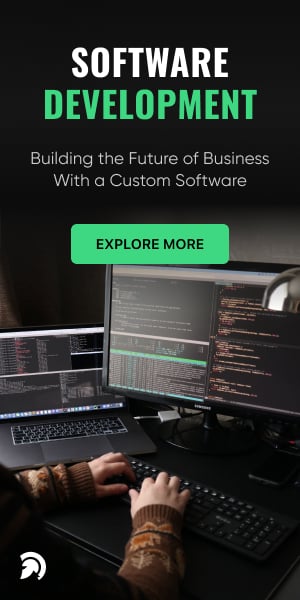In today’s technology-driven economy, custom software development isn’t just a supporting tool; it’s the foundation of modern business success. Across industries and regions, organizations of all sizes rely on different types of software development and tailored digital solutions to innovate, automate processes, and maintain a lasting competitive edge.
Yet “software development” is a broad umbrella that encompasses diverse disciplines, tools, and approaches, all designed to meet specific business objectives. Whether you’re exploring web, mobile, cloud, or AI-driven solutions, understanding the core types of software development helps you make smarter technology investments that align with your growth strategy.
In this comprehensive guide, we’ll explain what software development really means, explore its major types, discuss their business applications, and highlight how U.S. organizations can utilize them to stay ahead in an ever-evolving digital landscape.
What Is Software Development?
It is the process of conceptualizing, designing, coding, testing, and maintaining applications or systems that perform specific functions or solve real-world problems. It combines technical skill and creative problem-solving to transform ideas into practical, scalable digital solutions.
The process typically follows a structured framework known as the Software Development Life Cycle (SDLC) that includes stages such as requirement gathering, planning, analysis, design, coding, testing, deployment, and maintenance. Each stage ensures that the final product is functional, secure, and aligned with user and business goals.
Key Components of Software Development
- Programming Languages: Tools like Python, Java, C#, JavaScript, and Kotlin that developers use to build software.
- Frameworks & Tools: Libraries and ecosystems such as React, .NET, Django, and Spring that standardize and accelerate development.
- Methodologies: Agile, Scrum, and DevOps practices that enable flexible collaboration and continuous improvement.
- Testing & Quality Assurance: Procedures that ensure reliability, scalability, and security before launch.
Quick Stat:
According to the JetBrains “State of Developer Ecosystem 2024” report (23,000+ developers surveyed), JavaScript remains the most used language (61 %) in the past 12 months.
Top 15 Types of Software Development
1. Web Development
Web development forms the digital backbone of most organizations. It focuses on creating browser-based applications and websites that operate seamlessly across platforms and devices.
Web development involves three core layers:
- Front-end development: The user interface is built with HTML, CSS, JavaScript, and frameworks such as React, Angular, or Vue.js.
- Back-end development: The engine behind the scenes, using technologies such as Node.js, Python, PHP, Ruby, or Java to manage databases, logic, and APIs.
- Full-stack development: Combines both front and back-end skills to deliver end-to-end web solutions.
Business Use Case:
From eCommerce platforms to SaaS products and internal dashboards, web applications are vital for customer engagement, sales management, and operational efficiency.
Trend Insight:
Modern web development increasingly relies on Progressive Web Apps (PWAs), serverless architectures, and frameworks like Next.js to improve performance and scalability.
2. Mobile App Development
With over 310 million smartphone users in the U.S., mobile app development is essential for direct customer engagement and brand loyalty.
Main Categories:
- Native Apps: Built for the specific platforms (iOS or Android) using Swift, Objective-C, or Kotlin.
- Cross-Platform Apps: Developed once using frameworks like Flutter or React Native and deployed across platforms.
- Progressive Web Apps (PWAs): Web-based apps that behave like native mobile applications and can function offline.
Business Use Case:
Industries like retail, healthcare, logistics, and finance use mobile apps for real-time engagement and automation.
Trend Insight:
Emerging software development trends include AI integration, wearable connectivity, and super apps that combine multiple services within a single mobile ecosystem.
3. Cloud Software Development
It enables businesses to build and deploy scalable, internet-based applications using platforms like AWS, Microsoft Azure, or Google Cloud.
Key Benefits:
- On-demand scalability
- Cost efficiency and reduced infrastructure management
- Enhanced security and remote accessibility
Business Use Case:
Enterprises leverage cloud solutions for analytics platforms, CRM systems, and collaborative tools.
Trend Insight:
The rise of serverless computing, microservices, and multi-cloud strategies has transformed how U.S. companies approach scalability and digital transformation.
4. Desktop Software Development
While cloud and mobile dominate, desktop software remains vital in industries that demand high performance and offline reliability.
Technologies:
C++, .NET, Java, Python, and Electron (with emerging options like Tauri and Flutter Desktop).
Business Use Case:
Engineering firms, accounting practices, and creative studios depend on desktop apps for secure, high-performance tasks.
Trend Insight:
Hybrid desktop apps that integrate cloud synchronization now offer the best of both worlds, local reliability and online connectivity.
5. Embedded Systems and IoT Development
Embedded Systems and IoT Development powers smart devices and real-time systems across medical equipment, autonomous vehicles, and industrial automation.
Common Technologies:
C, C++, Rust, Python, and real-time operating systems (RTOS).
Business Use Case:
Manufacturers and innovators use embedded software to monitor equipment, automate production, and create connected products.
Trend Insight:
Embedded software development increasingly leverages edge computing, AI-powered sensors, and TinyML to process data locally for faster insights.
Quick Stat:
According to Grand View Research, the global embedded software market, comprising software that operates directly on hardware and IoT devices, is valued at approximately US $17.9 billion in 2024 and is projected to reach about US $30.2 billion by 2030, growing at a CAGR of around 9.5 %.
6. AI and Machine Learning Development
AI and machine learning (ML) are revolutionizing industries by automating decision-making, enhancing personalization, and unlocking data insights.
Core Technologies:
Python, TensorFlow, PyTorch, Keras, R, and Scikit-learn.
Applications Include:
- Predictive analytics
- Chatbots and virtual assistants
- Image and voice recognition
- Fraud detection and process automation
Business Use Case:
AI enables retailers to personalize shopping, banks to detect anomalies, and healthcare providers to diagnose faster.
Trend Insight:
The adoption of Generative AI, LangChain, and AutoML is accelerating innovation in 2025.
7. Game Development
Game development merges art, design, and coding to create interactive entertainment and simulations.
Key Engines:
Unity, Unreal Engine 5, Godot, and CryEngine.
Business Use Case:
Beyond entertainment, gamification is transforming education, corporate training, and marketing engagement.
Trend Insight:
The rise of VR/AR experiences and metaverse platforms continues to expand how businesses use game mechanics to drive user engagement.
8. Security Software Development
It focuses on building tools that prevent, detect, and respond to cyber threats, crucial in an era of rising ransomware and data breaches.
Key Types:
- Antivirus and firewall systems
- Encryption and authentication solutions
- Threat detection and monitoring tools
Business Use Case:
Banks, healthcare institutions, and government agencies rely on robust security solutions to protect sensitive data.
Trend Insight:
Modern cybersecurity emphasizes Zero Trust frameworks, AI-driven threat detection, and automated response orchestration.
9. DevOps and Infrastructure Development
DevOps bridges development and operations to ensure faster, more reliable software delivery through automation and continuous integration.
Tools:
Docker, Kubernetes, Jenkins, GitLab CI/CD, Terraform, and GitHub Actions.
Business Use Case:
American tech firms use DevOps to speed up release cycles and improve scalability.
Trend Insight:
DevOps has evolved into DevSecOps, embedding security into every stage of software delivery.
10. API and Integration Development
APIs (Application Programming Interfaces) enable secure and efficient communication between multiple software systems.
Common Types:
REST, SOAP, GraphQL, gRPC, and event-driven APIs.
Business Use Case:
APIs connect CRMs, ERPs, and payment systems, helping organizations unify data and streamline workflows.
Trend Insight:
The growth of API-first development and API marketplaces is transforming how businesses build scalable ecosystems.
11. Enterprise Software Development
Enterprise software unifies processes, departments, and data across large organizations, serving as the operational backbone.
Examples:
ERP, CRM, HRMS, and BI systems.
Business Use Case:
Used by enterprises to optimize workflows, automate tasks, and derive strategic insights.
Trend Insight:
The rise of low-code platforms, AI-driven analytics, and cloud-native enterprise systems enables faster innovation and integration.
12. E-Commerce Software Development
E-commerce software development enables businesses to sell products and services online while seamlessly managing transactions, inventory, and analytics.
Technologies:
Shopify, Magento, WooCommerce, BigCommerce, Laravel, and headless commerce frameworks like Next.js Commerce.
Business Use Case:
From local retailers to global D2C brands, online stores rely on optimized platforms to enhance user experience and drive conversions.
Trend Insight:
Emerging trends include AI-based personalization, voice commerce, and headless architecture for speed and flexibility.
13. Fintech Software Development
FinTech is transforming the way the world interacts with money by creating smarter, faster, and more transparent digital financial systems. Today’s FinTech solutions focus on building user trust, reducing transaction friction, and giving people more control over their financial experiences; all while ensuring top-level security and compliance.
Core Technologies Powering FinTech Innovation:
Modern FinTech products are powered by technologies such as Solidity, Ethereum, Hyperledger, Web3.js, Polygon, and Solana. It enable developers to create advanced financial applications that automate transactions, manage digital assets securely, and support decentralized ecosystems that remove the need for traditional intermediaries.
Business Use Case:
Used across banking, healthcare, and supply chains for secure, traceable transactions.
14. Data Science and Analytics Software Development
Data science and analytics software transform raw data into actionable insights, supporting strategic business decisions.
Tools:
Python, R, Apache Spark, Tableau, Power BI, Snowflake, Databricks.
Business Use Case:
Organizations use analytics for forecasting, performance tracking, and data-driven innovation.
Trend Insight:
The integration of AI analytics, real-time dashboards, and predictive modeling is reshaping business intelligence.
15. Custom Software Development
It delivers tailored solutions designed to match a company’s unique needs, goals, and workflows.
Key Advantages:
- Tailor-made functionality
- Seamless integration with existing systems
- Greater scalability and security
- Enhanced competitive advantage
Business Use Case:
Organizations across industries, from startups to Fortune 500s, leverage custom software development services to innovate faster, improve efficiency, and create differentiated user experiences.
Trend Insight:
As digital ecosystems grow increasingly complex, partnering with a custom software development firm helps integrate modern capabilities such as AI, IoT, and cloud-native design for long-term flexibility and ROI.
Quick Stat:
According to a GrandViewResearch report, North America, driven by strong demand in the U.S., captured more than 34% of the global custom software development market in 2024, with forecasts indicating robust growth through 2030.
How to Choose the Right Type of Software Development for Your Business
Choosing the right type of software development approach depends on your business objectives, operational needs, and digital maturity. With so many approaches from web and mobile apps to AI and enterprise systems, it’s essential to align your technology investment with what truly drives growth and efficiency.
Here are the key factors to consider when selecting the right software development approach:
1. Define Your Business Objectives
Start by identifying what you want your software to achieve.
- Customer-facing goals: such as improving engagement or sales, may require web or mobile app development.
- Operational goals: like automating workflows or managing data, may be better served through enterprise or cloud software.
- Innovation goals: such as adopting AI, blockchain, or IoT, point toward emerging technologies and custom development.
Having a clear outcome helps determine whether you need a quick off-the-shelf solution or a custom-built platform tailored to your vision.
2. Understand Your Target Users
Your target audience directly shapes the type of software and the design approach.
- If you want to gain a broad consumer base, mobile and web development may be ideal.
- For B2B or internal users, enterprise or desktop applications often provide better control and depth.
- If your users interact with physical devices, embedded systems, or IoT solutions, those may be most relevant.
By understanding your users’ behavior, devices, and expectations, you ensure the software delivers meaningful experiences.
3. Assess Scalability and Future Growth
Businesses evolve, your software should, too. If you anticipate growth, select technologies that support modular, cloud-native architectures. Cloud and DevOps approaches allow you to scale smoothly without disrupting performance or reliability.
For organizations with complex integrations, API-first development and microservices ensure long-term flexibility and reduced dependency on single systems.
4. Consider Budget and Time-to-Market
Budget and deadlines play a major role in determining the best development path.
- If you need a quick launch, cross-platform mobile apps or low-code tools can reduce development time.
- For long-term ROI, custom software development, though initially more resource-intensive, offers greater scalability, control, and competitive differentiation.
It’s about balancing speed, cost, and sustainability to achieve maximum business impact.
5. Evaluate Technical Complexity
Each type of software has different technical demands. If your project involves AI models, blockchain networks, or data analytics, you’ll need specialized development expertise. Partnering with the right custom software development company ensures your solution is built with the right technologies, security measures, and compliance standards.
6. Focus on Integration and Ecosystem Compatibility
Modern businesses rely on a range of digital tools, from CRMs and ERPs to analytics dashboards. When choosing a software type, consider how it will integrate with your existing systems.
API and integration development ensure seamless data flow and unified operations across departments.
7. Stay Informed About Emerging Trends
Technology evolves rapidly. Keep an eye on software development trends such as AI automation, serverless computing, low-code development, and hyper-personalization. Staying proactive helps ensure your investment remains future-ready and adaptable.
8. Choose a Trusted Technology Partner
Finally, your software’s success depends heavily on your development partner’s expertise. Look for a custom software development company that:
- Understands your industry and business goals.
- Has proven experience across multiple development types.
- Follows a structured software development life cycle to ensure quality and reliability.
A trusted partner like Evince Development can guide you from strategy and design to deployment and scaling, ensuring that your software not only works but delivers measurable business value.
Conclusion
Software development is the cornerstone of digital innovation and operational excellence. Whether your goal is to build a responsive web platform, a mobile app, an AI engine, or a secure enterprise solution, choosing the right development approach determines how effectively your business can scale and compete.
For U.S. companies, this often means embracing custom, cloud-native, and data-driven solutions that not only meet today’s needs but also prepare for tomorrow’s challenges.
Evince Development is a trusted technology partner to businesses across the USA, helping them design, develop, and deploy transformative software solutions. With deep expertise across multiple technologies and industries, we deliver software that doesn’t just solve problems, it powers growth and innovation.




